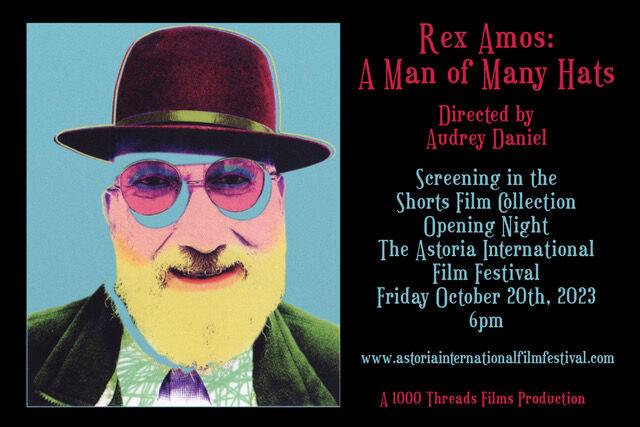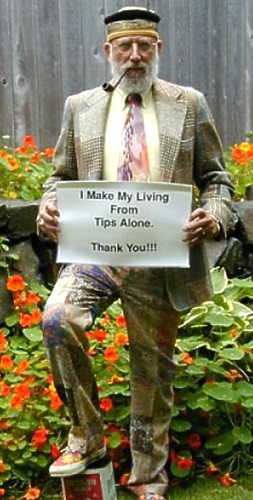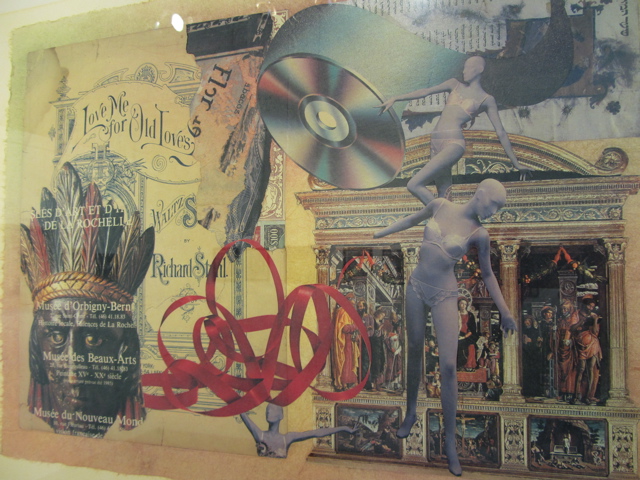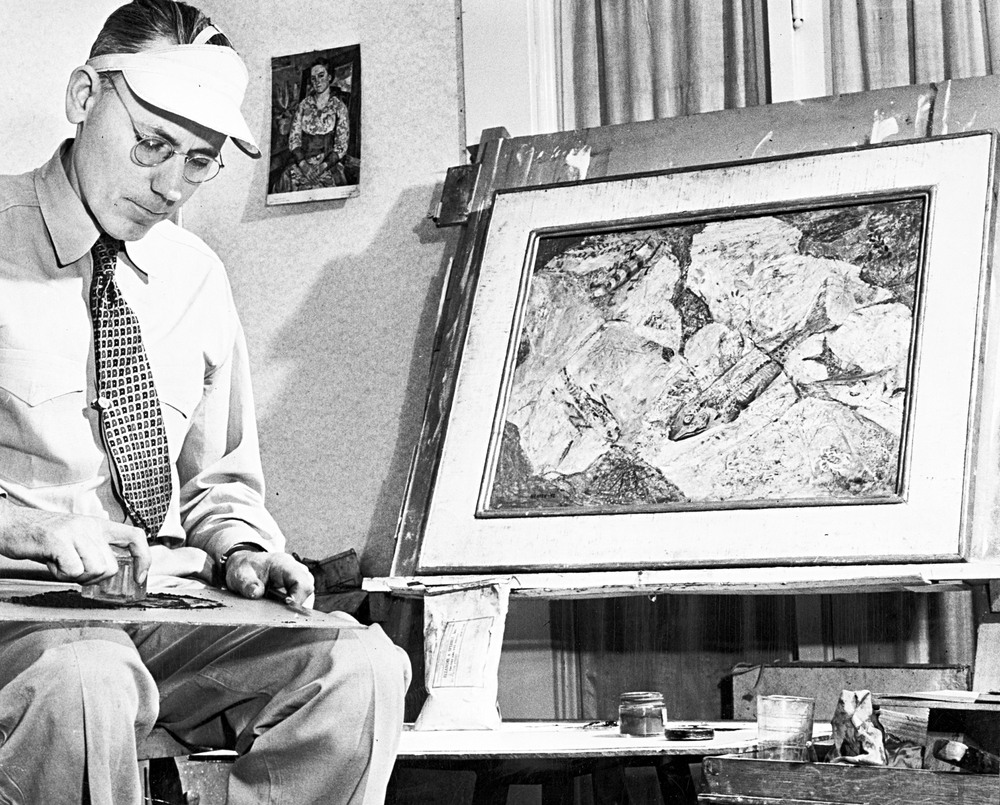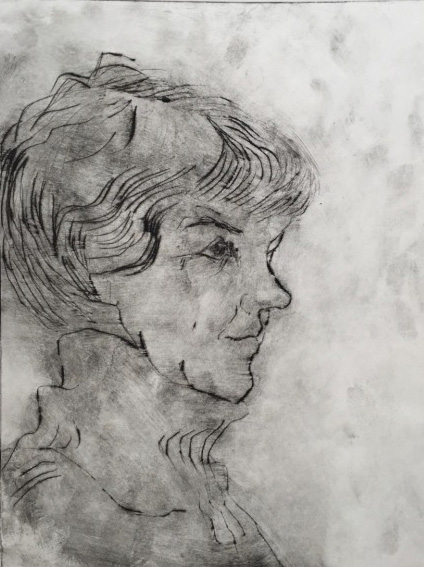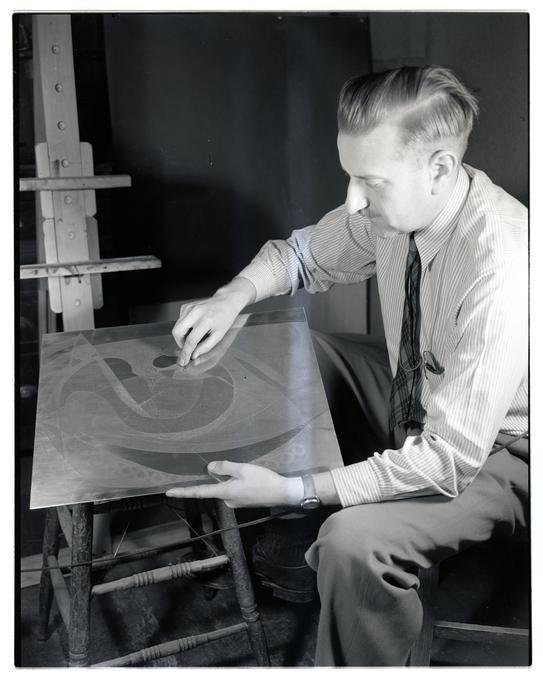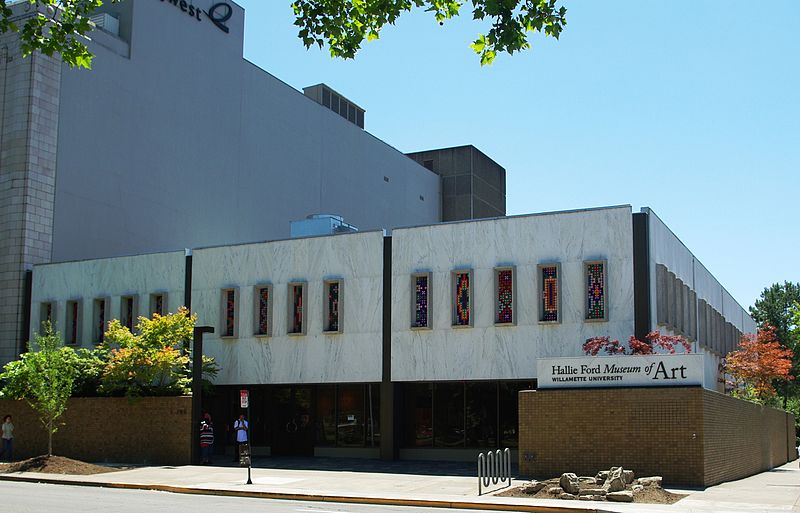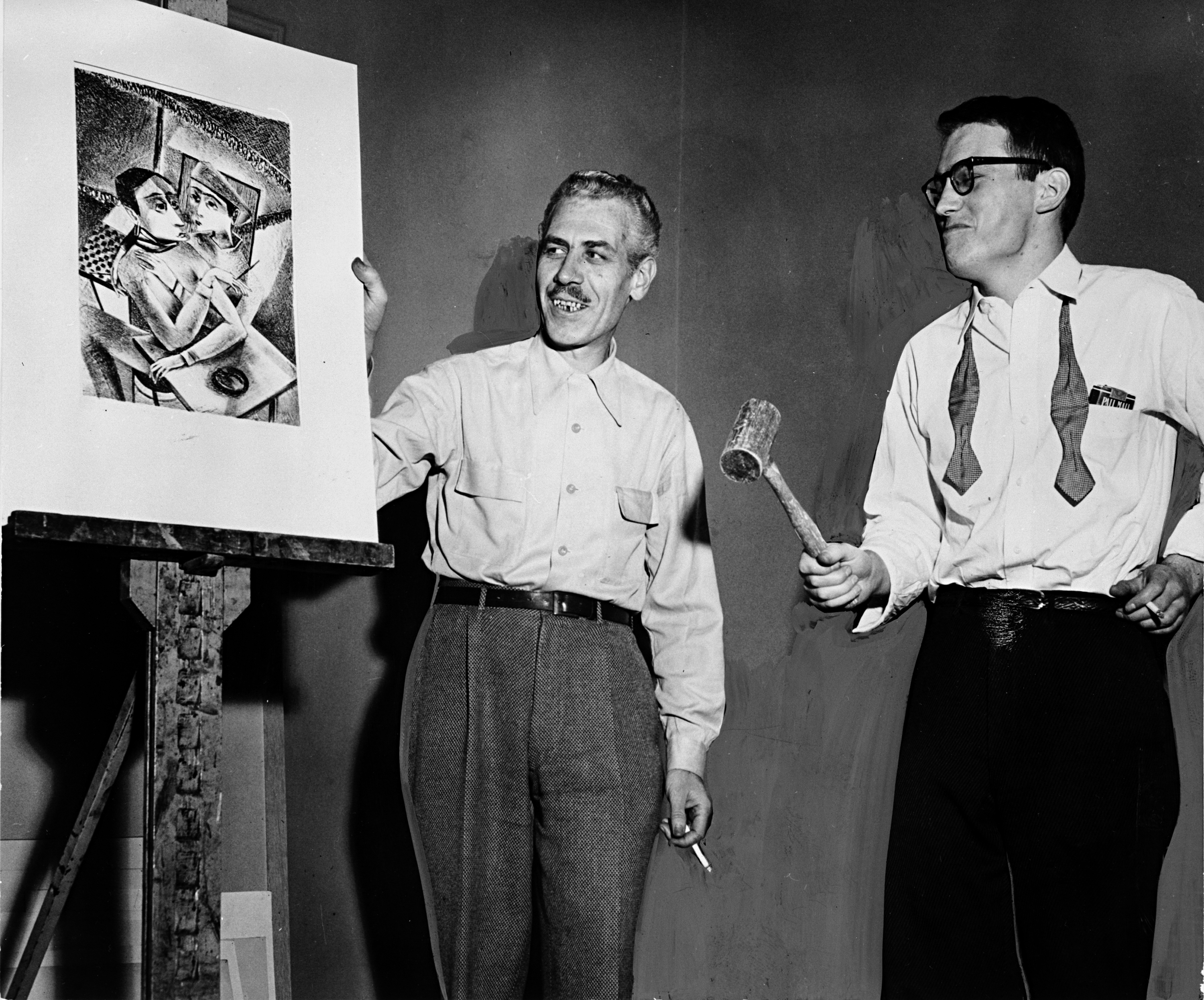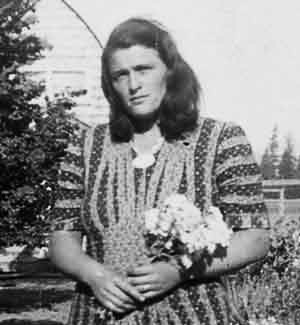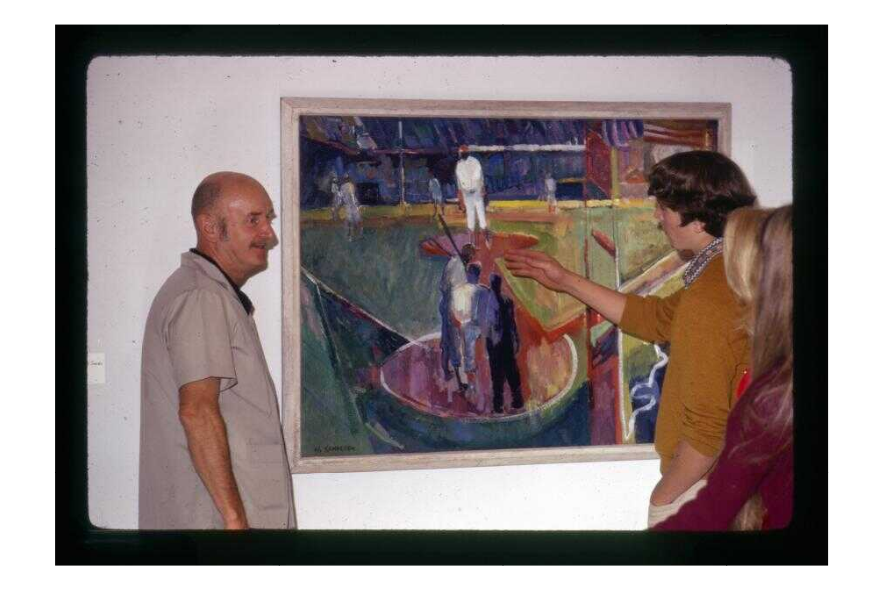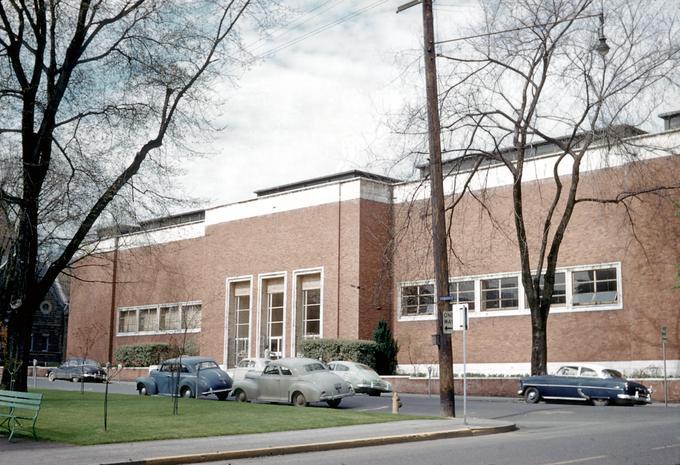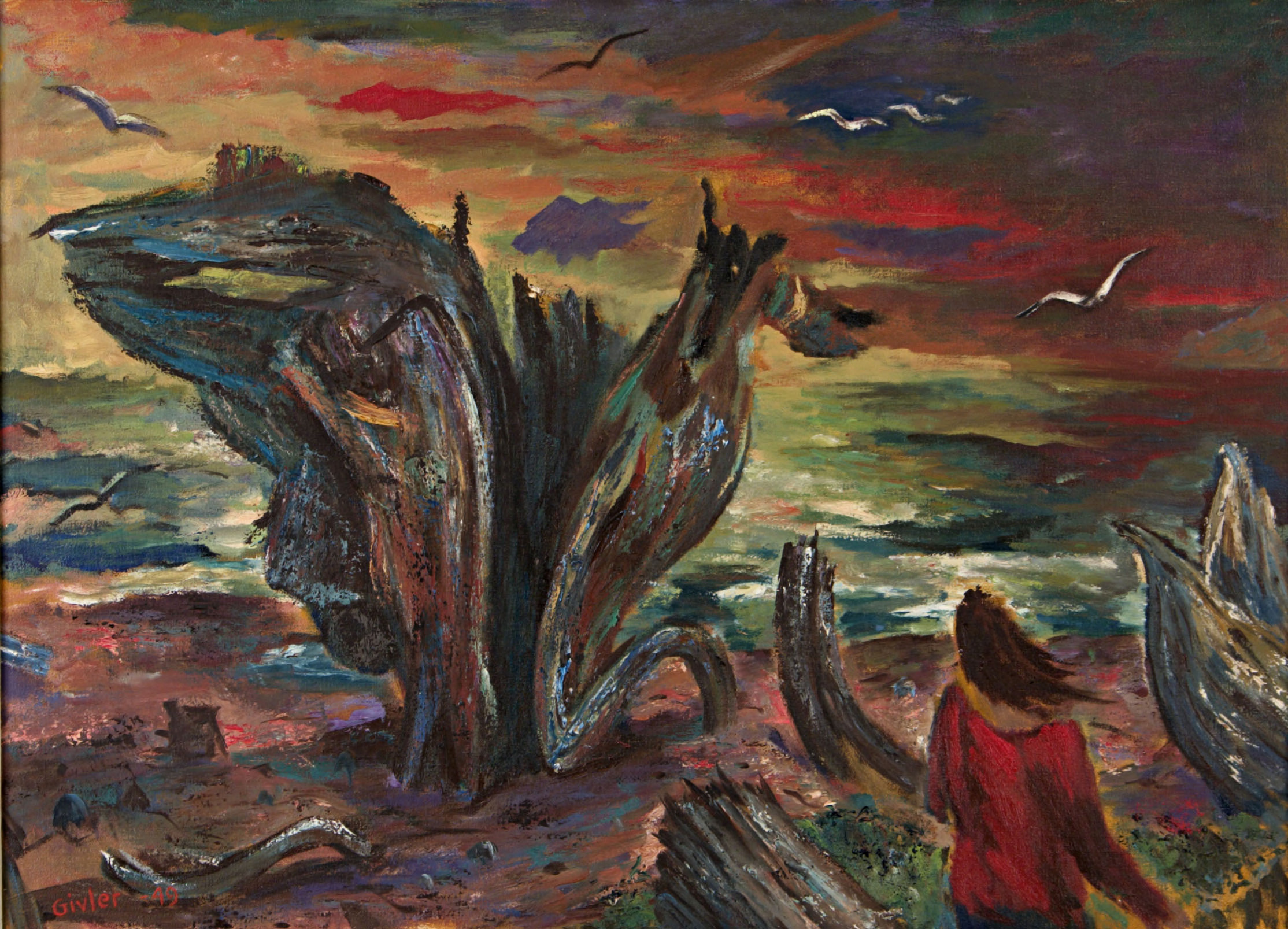Rex Amos is an Oregon artist and writer best known for his assemblage and precise collage work using the Chine collé method, which uses both collage and printmaking techniques. A prominent figure in the Portland art scene, especially during the 1960s and 1970s, Amos combines the bold visual and aesthetic aspects of collage with literary, historical, and political references, resulting in artwork that leaves a lasting impression with a strong message.
Amos was born in Wallace, Idaho, on August 13, 1935, to Frenche Harland and Jean Amos and spent his early childhood in the nearby town of Burke. The family moved to Portland when Amos was seven years old. After graduating from Washington High School, he was drafted into the U.S. Army. While serving a tour in Germany, he had opportunities to travel in Europe, where he visited museums, sparking his interest in creating art of his own. He returned to Portland in 1956 and moved with his mother to a new house to escape his father’s abuse. Shortly after, he met and married Diane Smith.
In 1959, Amos befriended Matt Glavin, an abstract expressionist painter who taught at the University of California, Berkeley. Glavin introduced him to Chine collé and gave him access to the Magnolia Editions fine art studio in Oakland, which gave Amos more space and resources to create. He returned to Magnolia Editions many times to use its press.
Amos studied literature and philosophy at Portland State University before moving to The Village, a neighborhood in southwest Portland known for its resident artists and writers. It was there that he experimented with abstract painting, discovered object sculpting, and took up jazz drumming. In 1960, he broke the world record for marathon jazz drumming when he played the drums for eighty-one hours and twenty minutes, an effort that led to the loss of his musicians’ union card for playing an unsanctioned job. He moved with his friend Ron Marcus to Big Sur, California, where he lived in a shack under a bridge and made a little money by working at the Big Sur Inn. He created artwork with salvage, which led him to create junk sculptures, an art form he has continued.
Over the next few years, Amos’s work was shown in several galleries in the Portland area. In 1963, Walter Powell, the founder of Powell’s Books, commissioned him to paint a series of icons for Saint John the Baptist Ukrainian Orthodox Church. In that work, Amos developed a technique that involves using small brushes to build and create figures from dark to light, a style that would become influential in his later works.
Amos became known for his precision, which earned him the nickname The Cutter. He incorporated symbols and words into many of his pieces, reflecting his literary background and his interest in philosophical, historical, and religious figures and themes, civil rights, and his opposition to the Vietnam War. Using delicate silver scissors meant for ocular surgery, he cut the pieces of his work so precisely and glued them so carefully that the edges of each piece could not be discerned.
He never stopped writing and making assemblages with found materials. One assemblage on the tragedy of September 11, 2001, is documented in A World of Art, by art historian Henry Sayre. 9/11 is a boxed assemblage with a collage of newspaper clippings and photos from the time of the attacks, with pieces of salvage scrap metal pressed into a circular pattern. A cross and crucifix are at its center. The piece is jarring and entrancing and invites viewers to consider the destruction of the World Trade Center in New York City.
Amos’s interest in literature and philosophy had a profound impact on his life and his creative endeavors, and he has written articles, papers, and poetry on a variety of art and philosophical topics. While working on his bachelor’s degree at Portland State University in early 1965, he created a philosophy that he named Preliminism. “In preliminism,” Graham Conroy, professor of aesthetics at PSU, wrote, “process, prelude and prologue are everything. Beginnings are perpetual. Perfection is a mirage, attainment is monotonous and anticlimactic. Everything is over before it begins. Hence practice makes practice.”
Amos lives and works in Cannon Beach with his wife Diane. His work has been shown in museums and galleries in Oregon and California, including the Portland Art Museum, Magnolia Editions, the Augen Gallery in Portland, and the Hallie Ford Museum of Art at Willamette University. A collection of his work and writing is in the Pacific Northwest Artists Archives in the Mark O. Hatfield Library at Willamette.
-
![]()
Rex Amos (right) with Roger Hull, Hallie Ford Museum exhibition, 2013.
Courtesy Bonnie Hull -
![]()
Gutterscape #5, by Rex Amos.
Courtesy Hallie Ford Museum, Willamette University -
![]()
Rex Amos: A Man of Many Hats, documentary poster, 2023.
Courtesy Astoria International Film Festival -
![]()
Rex Amos, Cannon Beach.
Courtesy Rex Amos -
![]()
A Chine colle by Rex Amos, Hallie Ford Exhibition, 2013.
Courtesy Bonnie Hull
Related Entries
-
![Charles Edward Heaney (1897-1981)]()
Charles Edward Heaney (1897-1981)
Charles Heaney was a printmaker and painter in Oregon for nearly sixty …
-
![Eunice Lulu Parsons (1916–2024)]()
Eunice Lulu Parsons (1916–2024)
“Edges are the story of my life,” artist Eunice Parsons told an intervi…
-
![Gordon Waverly Gilkey (1912–2000)]()
Gordon Waverly Gilkey (1912–2000)
Gordon Waverly Gilkey was a Monuments, Fine Arts, and Archives officer …
-
Hallie Ford Museum of Art
The Hallie Ford Museum of Art at Willamette University has only been in…
-
![Manuel Izquierdo (1925 - 2009)]()
Manuel Izquierdo (1925 - 2009)
Manuel Izquierdo, who arrived in Portland in 1942 as a teenaged refugee…
-
![Martina Gangle Curl (1906 - 1994)]()
Martina Gangle Curl (1906 - 1994)
Martina Gangle Curl was a painter, printmaker, and woodcarver who creat…
-
![Nelson Sandgren (1917-2006)]()
Nelson Sandgren (1917-2006)
Nelson Sandgren was a painter and printmaker who taught at Oregon State…
-
![Portland Art Museum]()
Portland Art Museum
The Portland Art Museum, which opened in 1895 in the city library with …
-
![William Givler (1908-2000)]()
William Givler (1908-2000)
William Givler was an artist and educator who joined the faculty of the…
Map This on the Oregon History WayFinder
The Oregon History Wayfinder is an interactive map that identifies significant places, people, and events in Oregon history.
Further Reading
Hull, Bonnie. “Living the Creative Life: Matt Glavin.” On The Way, February 25, 2011.
Hull, Bonnie. “Living the Creative Life: Rex Amos.” On The Way, February 24, 2011.
Hamil, Johm. “Rex Amos Biography and Bibliography.” jwhamil.com.
Sayre, Henry M. A World of Art. 8th ed. Boston, Mass.: Prentice Hall, 2016.



